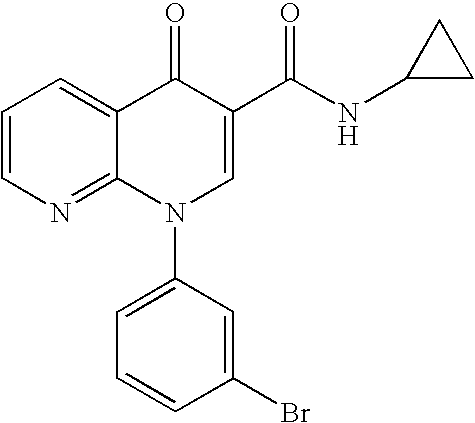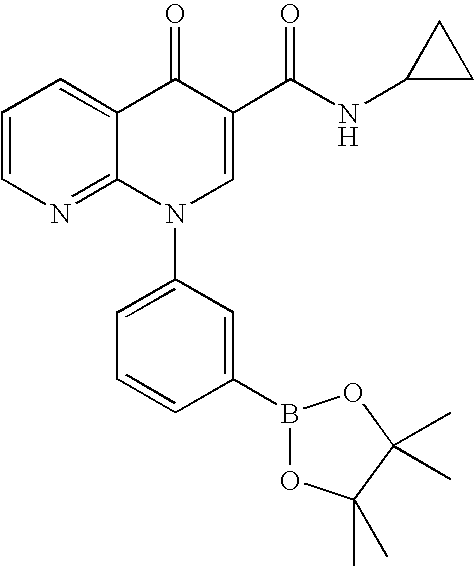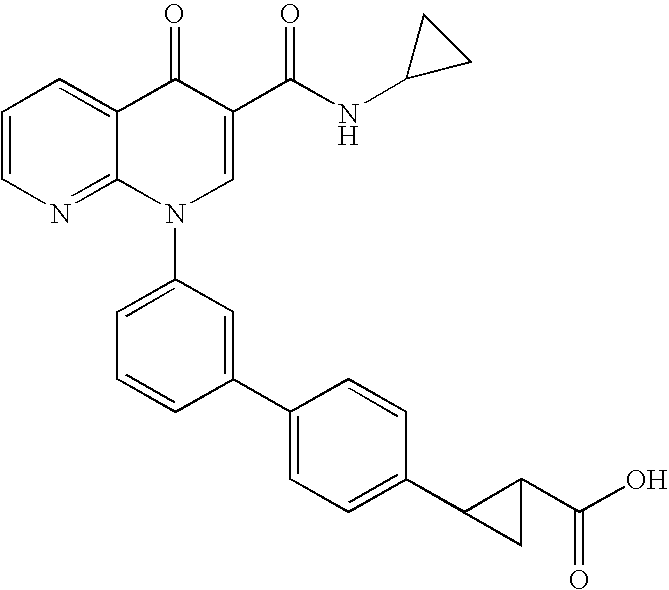Use of phosphatase inhibitors as adjunct therapy for psychiatric disorders
a phosphatase inhibitor and adjunct therapy technology, applied in the direction of biocide, heterocyclic compound active ingredients, drug compositions, etc., can solve the problems of not being able the use of this combination therapy, and the inability of davis et al. to disclose the use of pde4 inhibitors in combination with psychotherapy, so as to improve the effectiveness of psychotherapy, improve symptoms, and short interval
- Summary
- Abstract
- Description
- Claims
- Application Information
AI Technical Summary
Benefits of technology
Problems solved by technology
Method used
Image
Examples
example 1c
2-(trans)-{3′-[3-[(Cyclopropylamino)carbonyl]-4-oxo-1,8-naphthyridin-1(4H)-yl]-1,1′-biphenyl-4-yl}cyclopropanecarboxylic acid
[0146]
Step 1: Ethyl 2-(trans)-(4-bromophenyl)cyclopropanecarboxylate
[0147] To a mixture of ethyl 4-bromocinnamate and Pd(OAc)2 (0.05 eq) in methylene chloride (1M) at 0° C. was added dropwise a solution of CH2N2 in ether until the reaction was completed by NMR analysis. The mixture was filtered through a plug of silica gel and concentrated to afford the title compound as an oil.
Step 2: Ethyl 2-(trans)-[4-(4,4,5,5-tetramethyl-1,3,2-dioxaborolan-2-yl)phenyl]cyclopropanecarboxylate
[0148] A mixture of bromide from step 1 (1.0 eq), pinacol diborane ester (1.4 eq), KOAc (3.5 eq) and PdCl2(dppf)2 (0.03 eq) in DMF (0.14M) was stirred at 60° C. for 24 h. The resulting mixture was cooled to rt, diluted with EtOAc:hexane (1:1). The organic phase was washed with water (3×), brine, dried over MgSO4, filtered and concentrated. Flash chromatography (hexane:EtOAc; 90:10) ...
example 2c
2-{3′-[3-[(Cyclopropylamino)carbonyl]-4-oxo-1,8-naphthyridin-1(4H)-yl]-1,1′-biphenyl-4-yl}-2-methylpropanoic acid
[0162]
Step 1: Methyl 2-(4-bromophenyl)-2-methylpropanoate
[0163] To a solution of LiHMDS (1M, THF, 2.1 eq) in THF (0.06M) was added methyl 4-bromophenylacetate (1 eq). After 15 min, MeI (4 eq) was added and the reaction mixture slowly warmed to rt and stirred for 18 h. The mixture was quenched with HCl 10%, diluted with EtOAc, washed with HCl 10%, brine, dried and solvent evaporated. Flash chromatography (Hexane:EtOAc:, 95:5) afforded the title compound.
Step 2: 2-(4-Bromophenyl)-2-methylpropanoic acid
[0164] To a solution of ester from step 1 in THF-MeOH (4:1, 0.5M) was added LiOH (3 eq, 2M) and the mixture was stirred at 50° C. for 1 h. The organic solvent evaporated, aqueous was acidified with HCl 1 N and the acid extracted with EtOAc (3×). The organic was washed with brine, dried and solvent evaporated to afford the acid.
Step 3: 2-{3′-[3-[(Cyclopropylamino)carbonyl]...
example 3c
3-{3′-[3-[(Cyclopropylamino)carbonyl]-4-oxo-1,8-naphthyridin-1(4H)-yl]-1,1′-biphenyl-4-yl}-3-methylbutanoic acid
[0167]
[0168] Prepared according to the procedure described in EXAMPLE 2C, step 2 and 3 but using 3-(4-iodo-phenyl)-3-methyl-butyric acid methyl ester (prepared according to the procedure described in J. Am. Chem. Soc. 1948, 70, 370) as starting material. Flash chromatography (CH2Cl2:EtOAc, 40:60, 2% AcOH) afforded the title compound as a white solid.
[0169]1H NMR (500 MHz, DMSO-d6): δ 9.75 (d, 1H); 8.82 (s, 1H), 8.78 (dd, 1H), 8.72 (dd, 1H), 7.94 (s, 1H), 7.86 (d, 1H), 7.68-7.60 (m, 2H), 7.66 (d, 2H), 7.57 (d, 1H), 7.49 (d, 2H), 2.88 (m, 1H), 260 (s, 2H), 1.40 (s, 6H), 0.76 (m, 2H), 0.55 (m, 2H).
PUM
| Property | Measurement | Unit |
|---|---|---|
| weight | aaaaa | aaaaa |
| temperature | aaaaa | aaaaa |
| pH | aaaaa | aaaaa |
Abstract
Description
Claims
Application Information
 Login to View More
Login to View More - R&D
- Intellectual Property
- Life Sciences
- Materials
- Tech Scout
- Unparalleled Data Quality
- Higher Quality Content
- 60% Fewer Hallucinations
Browse by: Latest US Patents, China's latest patents, Technical Efficacy Thesaurus, Application Domain, Technology Topic, Popular Technical Reports.
© 2025 PatSnap. All rights reserved.Legal|Privacy policy|Modern Slavery Act Transparency Statement|Sitemap|About US| Contact US: help@patsnap.com



